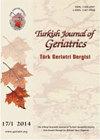RISK FACTORS FOR PROLONGED INTENSIVE CARE UNIT STAYS IN ELDERLY PATIENTS AFTER CARDIAC SURGERY: A RETROSPECTIVE OBSERVATIONAL STUDY
IF 0.3
4区 医学
Q4 GERIATRICS & GERONTOLOGY
Turkish Journal of Geriatrics-Turk Geriatri Dergisi
Pub Date : 2023-01-01
DOI:10.29400/tjgeri.2023.359
引用次数: 0
Abstract
Introduction: With the increase in life expectancy and developments in surgical and anesthetic techniques, intensive care follow-up, and treatment methods, the number of patients undergoing open-heart surgery has increased. Methods: The clinical files of 220 patients who underwent cardiovascular surgery were retrospectively reviewed. The patients were divided into two groups: group 1 (those who stayed for one day or less) and group 2 (those who stayed for more than one day). In addition, the reason for hospitalization for five days or more was investigated. The effect of patient variables on the length of stay in the intensive care unit was investigated by logistic regression analysis. Results: Hemoglobin values, ejection fraction values, and intensive care unit hospitalizations were significantly lower (p<0.05) than those in the group with intensive care unit hospitalizations of <24 h. The sodium value was significantly higher (p<0.05) in the group with intensive care unit hospitalizations >24 h than in the group with intensive care unit hospitalizations <24 h. The pacemaker requirement rate in the group with intensive care unit hospitalizations >24 h was significantly (p<0.05) higher than the group with intensive care unit hospitalizations < 24 h. The sinus rhythm in the group with intensive care unit hospitalizations >24 h was significantly lower (p<0.05) than that in the group with intensive care unit hospitalizations <24 h. Intensive care transfusion of erythrocyte suspension, fresh frozen plasma, and platelet suspension were significantly higher (p<0.05) in the group with intensive care unit hospitalizations >24 h than in the group with intensive care unit hospitalizations <24 h. Conclusion: In our study; We found that factors such as preoperative low ejection fraction (EF), hypernatremia, female gender, inotrope requirement, delirium, extubation time, intraoperative-postoperative transfusion, drainage revision affect the length of stay in the intensive care unit In the intraoperative period, methods to protect myocardial and kidney functions and provide hemostasis bleeding control reduce the duration of intensive care hospitalization Keywords: Thoracic Surgery; Length of Stay; Critical Care; Aging.老年患者心脏手术后重症监护病房延长的危险因素:一项回顾性观察性研究
导读:随着预期寿命的延长以及外科和麻醉技术、重症监护随访和治疗方法的发展,接受心脏直视手术的患者数量有所增加。方法:回顾性分析220例心血管手术患者的临床资料。将患者分为两组:1组(住院1天及以下)和2组(住院1天以上)。此外,还调查了住院5天或更长时间的原因。采用logistic回归分析探讨患者变量对重症监护病房住院时间的影响。结果:血红蛋白值,射血分数值和重症监护室住院(术中;0.05)显著低于那些在重症监护室住院的集团& lt; 24 h。钠值明显高于(术中;0.05)组和重症监护室住院在24小时比组和重症监护室住院& lt; 24 h。该集团的起搏器需求率与重症监护室住院在24小时显著(术中;0.05)高于组重症监护病房住院情况<24 h重症监护室组窦性心律显著低于重症监护室组(p<0.05),重症监护室组输血红细胞悬液、新鲜冷冻血浆、血小板悬液显著高于重症监护室组(p<0.05)。我们发现术前低射血分数(EF)、高钠血症、女性、肌力需求、谵妄、拔管时间、术中术后输血、引流改道等因素影响患者在重症监护病房的住院时间。术中采取保护心肌、肾功能、止血控制等措施可减少重症监护住院时间。关键词:胸外科;逗留时间;急救护理;老化。
本文章由计算机程序翻译,如有差异,请以英文原文为准。
求助全文
约1分钟内获得全文
求助全文
来源期刊

Turkish Journal of Geriatrics-Turk Geriatri Dergisi
GERIATRICS & GERONTOLOGY-
CiteScore
0.60
自引率
0.00%
发文量
46
审稿时长
6-12 weeks
期刊介绍:
Turkish Journal of Geriatrics is a peer-reviewed journal. Official language of the journal is English. Turkish Journal of Geriatrics invites submission of Original Articles based on clinical and laboratory studies. Review Articles are published only after the invitation from the Editorial Board.
 求助内容:
求助内容: 应助结果提醒方式:
应助结果提醒方式:


